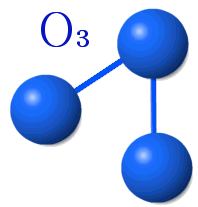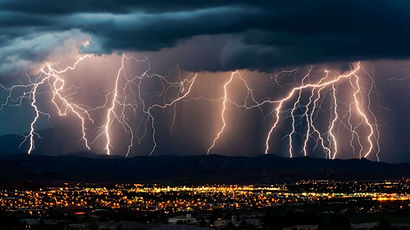OZONE

El OZONO tiene una doble función de eliminar gérmenes que no forman parte del aire limpio y filtrar los rayos ultravioleta del sol.
Ozone (O 3 )
Discovery of Ozone
In the year 1863 the scientist SORET demonstrated that ozone is composed only of 3 atoms of nascent oxygen (O 3 ). Until MP OTTO managed to determine its density, molecular constitution and carefully studied its formation. After these studies he devised the system to produce ozone by means of electrical discharges (as produced by nature itself) giving rise to the OTTO system which has been applied since 1969 in Galaxy Ozon generators.
What is Ozone?
Ozone is an allotropic (unstable) variety of oxygen, its triatomic molecule (O 3 ) is generated by the activation of the diatomic molecule (O 2 ) of oxygen. This activation can be caused by the action of an electrical discharge or by the energy radiated from ultraviolet rays.

How is ozone produced in nature?
It occurs naturally in two ways:

1.- In the upper layers of the atmosphere through the action of ultraviolet rays on atmospheric oxygen, forming the so-called ozone layer or ozone layer, whose mission is precisely to filter ultraviolet radiation from the sun into space.
2.- Through the activation of oxygen by means of high voltage electrical discharges produced by electrical storms .

artificial generation
It is done by activating the oxygen in the air by high-voltage electrical discharges. This electrical energy breaks the oxygen molecule, recombining its atoms to form OZONE. Just as Nature does in storms.
The release of energy when generating ozone is an endothermic process, whose energy comes from the electrical discharge. In the same way, ozone decomposes spontaneously into diatomic oxygen, with the release of excess energy, for which it must be generated immediately at the time and place of its use. For this, equipment called "Ozonizers" or ozone generators are used.
Due to pollution in large cities, photochemical formation occurs from pollutants emitted by vehicles or industries, called "Tropospheric Ozone".
Properties
of
Ozone


It is worldwide recognized that ozone is a BACTERICIDE , VIRICIDE , FUNGICIDE and DEODORANT ; in water purification it destroys streptococci, staphylococci, colibacilli, etc., as well as the most energetic diphtheria and tetanus toxins very quickly (3,000 times faster than chlorine).
OZONE performs two fundamental actions: microbicide and deodorant.

1.- Microbicide
Ozone can be considered the fastest and most effective microbicide agent known. Its action has a wide spectrum that includes the elimination of:
bacteria.
Virus.
Mushrooms.
spores
a) Bactericide:
Since the beginning of the 20th century it began to be used in the treatment of
Water. Subsequently to purify the air and even directly
sobre el human organism for therapeutic purposes (Ozone therapy).
One of the most important advantages of ozone, with respect to other
bactericides is that this effect becomes evident at low
concentrations and for very short exposure periods is
a perfectly observable bacteriostatic effect.
The difference between a bactericidal effect and a bacteriostatic effect is simple: a bactericidal agent is capable of killing bacteria. However, a bacteriostatic agent does not kill them, but it does prevent them from reproducing, rapidly slowing down the growth of their populations.
Although theoretically they are very different effects, in practice a population of bacteria without the capacity to reproduce is a population condemned to disappear. In fact, antimicrobial agents as important as some antibiotics base their power on a bacteriostatic action.


b) Viricide:
Viruses today considered border between living beings and inert matter, are not capable of living or reproducing if it is not by parasitizing cells that cause their destruction.
Unlike bacteria, viruses are always harmful and cause such common diseases as the flu, colds, measles, smallpox, chicken pox, rubella, polio, AIDS (HIV), hepatitis, etc.
Ozone acts on them by oxidizing their envelope proteins and modifying their three- dimensional structure. When this happens, the virus cannot bind to any host cell because it does not recognize its anchor point, and being unprotected it cannot reproduce and dies.
b) Fungicide:
There are certain types of fungi that have the ability to cause disease. Many others are capable of causing alterations in our food, making it unacceptable for consumption, as is the case with mold.
With ozonation we will eliminate these pathogenic forms, whose spores are in all kinds of environments, also avoiding possible cell damage.

b) Sporicidal:
There are some fungi and bacteria that, when conditions are adverse for their development, make a thick envelope around them and paralyze their metabolic activity, remaining in a state of lactation. When the conditions for survival become favorable again and their metabolism resumes activity. These forms of resistance are known as spores and are typical of bacteria as pathogenic as those that cause tetanus, gangrene, botulism or anthrax.
This type of resistance mechanism makes it very difficult to fight them and useful treatments in other cases, such as high temperatures and a multitude of antimicrobials, become ineffective. With ozonation they are radically eliminated.

2.- Deodorant
It is one of the easily verifiable properties that is very useful in eliminating unpleasant odours. Ozone has the property of destroying odors by attacking directly on the cause that produces them, without adding any chemical component.
What is the cause of bad odours?
In closed places, the cause is usually organic matter in suspension and the action of different microorganisms produced by sweat, humidity, tobacco, food, etc.
Ozone attacks both causes, on the one hand it destroys organic matter by ozonolysis and on the other hand it attacks the microbes that feed on it.
